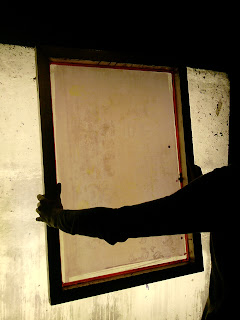Two Tone Devore Recipe:
Kenanthrol:
1 ½ tsp / 7g dye powder
2 tbsp/ 20ml warm water
2 tbsp ammonium sulphate
Stir until fully dissolved
Procion Mx
1 tsp/ 5g dye powder
2 tbsp/ 20ml warm water
2 tbsp/ 20g sodium chloride (household salt)
Stir until fully dissolved
I added these mixtures to a 4000ml dye water, which is just water in a bucket. I mixed it together using a large spoon.... Wet my velvet. Then dunked it slowly into the dye bath. I stirred it to make sure the dye had disperse to avoid air bubbles which create uneven coverage. I left it for roughly 30 minutes and rinsed under cold water, then hot water. I alternated until the water ran clear. i dried my fabric in a spin dryer for a few minutes.
I then repeated the same process as mentioned in my previous post about printing with devore paste. Once I had printed and left to dry, I scrubbed away the devore section and was left with a stencil like effect. I used a Kenanthrol Gold Antique dye and a Procion Mx Charcoal.
 |
| My Sample. I taped my sample to the window, so that you guys can see the effect better. The outline of the feather is the area in which I printed with using the devore paste. |
You can see in the photo above that the charcoal dye has taken to the main pile of the velvet and the antique gold has taken to the other threads of the fabric.





















